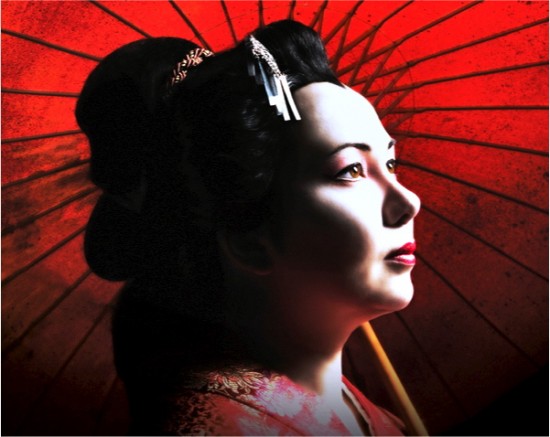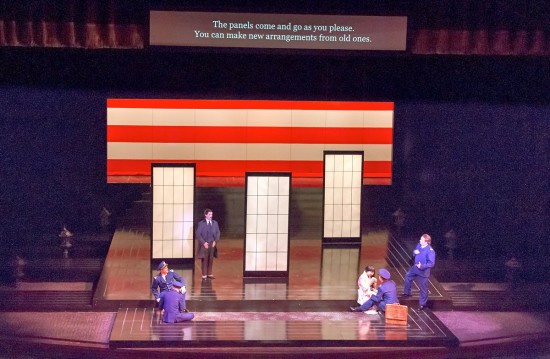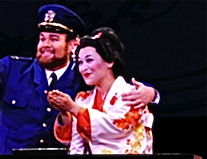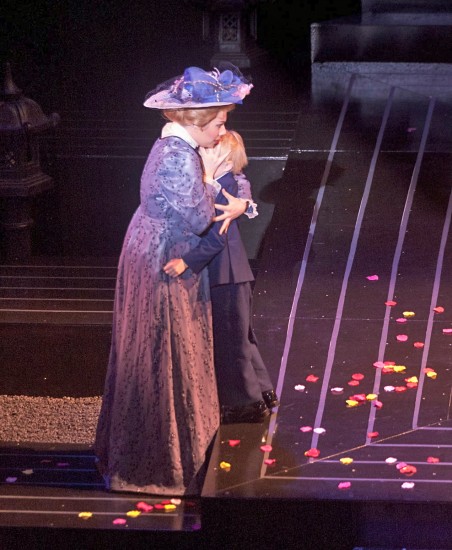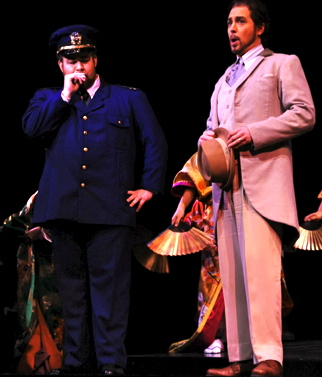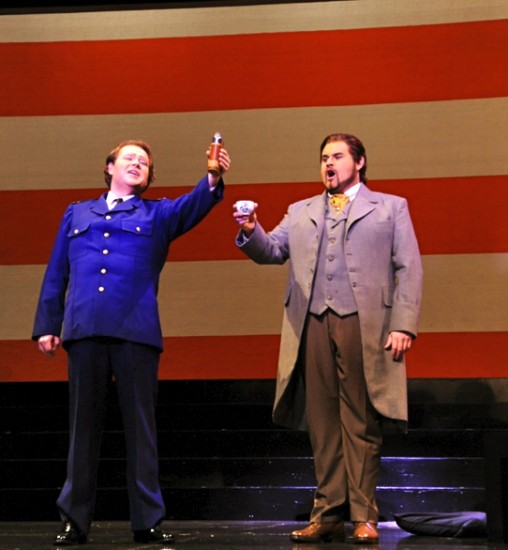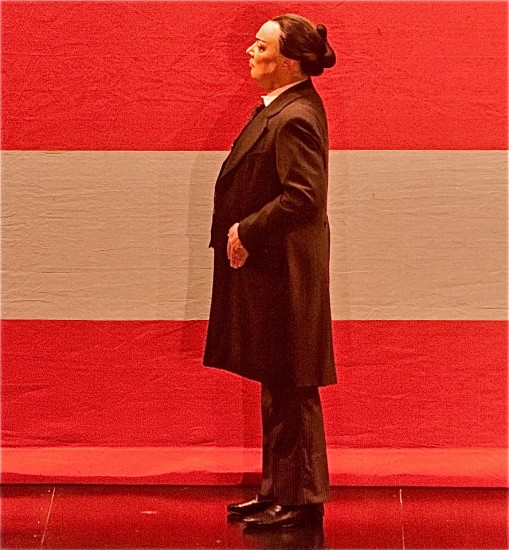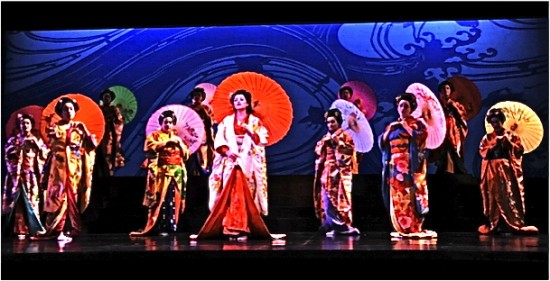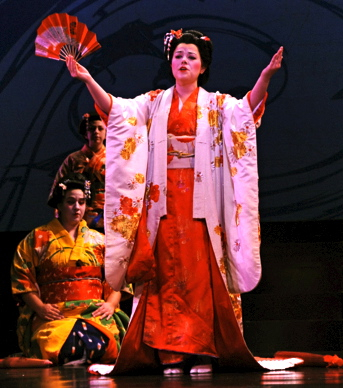There is only one possible word to describe Act I of the opera I saw on Sunday, February 16, 2014 – Beautiful. Never has Puccini’s gorgeous music been played with such delicate precision.
Conductor David Rohrbaugh, leading the San Jose Opera Orchestra for his final year before retiring, kept the orchestra in perfect synch with the singers, and his handling of the extended quiet musical passages at the ends of Act I and Act II was exquisite. At the end of Act I the audience paid him the ultimate tribute of withholding their applause until Puccini’s last quiet note had been played and he lowered his arms.
The minimalist sets consisted a background scrim, which changed with the seasons, the action, and the time of day, together with three panels which were raised and lowered; sometimes they were translucent windows to indicate the Japanese house with its sliding panels. Other times they would be floral or abstract designs to enhance the back scrim. The only props were a couple of chairs and a tea table, carried on and off by unobtrusive servants. Along with the lighting, the total effect enhanced the stage action but never became obtrusive.
Madama Butterfly is set in Japan at the end of the 19th century. After centuries of resisting any contact with Western civilization, Japan is just beginning to open up and interact with the rest of the world, but this process is at the upper levels of government and industry; life for ordinary people in Japan is still very different from life for ordinary people in the United States. In particular, the social structure is extremely rigid. The social status of an individual is precisely and immutably fixed by the circumstances of his or her birth. The sons of Royalty will be noblemen; the sons of Warriors will be warriors; the sons of Farmers will be farmers, etc. Society is absolutely sexist – women are inferior to men; period.
The drama and tension in the opera comes from the interaction of the two different cultures – specifically the Japanese geisha Cio-Cio-San and her personal servant Suzuki with Americans Naval Lieutenant Benjamin Franklin Pinkerton and Sharpless, the American Consul. The director of a production can take either of two distinct approaches (or anything in between, of course): take each culture at face value and emphasize the conflict, or search beneath the culture externals to find the commonality, “people are people”.
Stage Director Brad Dalton has chosen the first extreme, but has implemented it in a far from simple fashion. There is overt conflict in Act I in the encounter between Pinkerton and the Bonze, but it is quickly glossed over. The seeds of future conflict are evident as Pinkerton and Cio-Cio-San clearly indicate the difference in their expectations regarding their marriage – but not to each other.
The act ends with both of them extremely happy in each other’s arms.
Act II is all Cio-Cio-San. Three years have passed with no word from Pinkerton. According to Japanese law, he has deserted her and hence ipso factor divorced her. She has a son, Trouble, conceived in wedlock but born after desertion and without his father’s knowledge. Cio-Cio-San remains firm in her faith that Pinkerton will return and they will “live happily ever after” despite the efforts by Suzuki, Sharpless, and the marriage broker Goro to make her face reality.
In Act III reality takes over with a vengeance. The act is the antithesis of “Beautiful”. In my opinion it is downright “Ugly” – and frankly, I don’t like it. As I have said before, part of my enjoyment of opera – particularly tragic opera – is emotional. As Cio-Cio-San is preparing to commit harakiri with her father’s ceremonial sword (It is better to die with honor than to live without it) there is a little lump of sadness in my throat at the tragedy of it all. But apparently the sword misses her heart; she is still alive when Pinkerton rushes in, grabs her in his arms and pulls out the sword. Kate, arriving a second later, sees Pinkerton apparently brandishing the sword as if he had killed her. Unbelieving horror is on her face as she grabs Trouble in her arms and stumbles off stage. My own state of gentle sadness is rudely shattered as I share Kate’s horror. I feel emotionally betrayed. I don’t like it.
Enough negativism. Despite the ending, the production was fascinating and I look forward to seeing it again Sunday with the other cast. There is no question about Cio-Cio-San being the lead role – and soprano Cecilia Violetta L�pez was fully up to the challenge. L�pez doesn’t sound like a typical Japanese name, but she looked and acted the part perfectly. Lisa Chavez’ Suzuki was the perfect foil for the heroine. She did her best to make Cio-Cio-San face reality, but never forgot that she was only a servant and was completely subservient to the wishes and whims of her mistress.
I have seen many, many Butterflys, but this production gave me new insights into both of the male leads. I had always looked at Pinkerton as one of the most despicable characters in all opera for his treatment of Cio-Cio-San, but James Callon makes him seem to be more a victim of his own narrow-minded class. In his culture there are “humans” – meaning white males – and there are “others” who may have many desirable qualities but are not really human. It doesn’t make his actions any less heinous, but responsibility for them is only partly on his own shoulders – his whole culture is at fault.
Zachary Altman’s performance gave me new insight into Sharpless. Previously I had thought of him as basically a nice guy, but weak and ineffectual. He is much worse. In Act I he is an abettor. At the very beginning, before the opera starts, he puts Pinkerton in touch with Goro, the marriage broker, instead of telling Pinkerton he’ll have nothing to do with his nefarious scheme. Even worse, when confronted with Cio-Cio-San’s death and Pinkerton’s professed remorse, he has no support to offer either party, but can only say, “Told you so, told you so; yah, yah; it’s not my fault.” A fine friend!
I can’t finish this review without mentioning Michael Mendelsohn who plays the minor role of Goro, the marriage broker. I first saw Michael almost 20 years ago as a regular with Pocket Opera, and in the years between I have seen him in countless roles – usually minor – with Opera San Jose and West Bay Opera. I am always impressed by the way he throws himself into his role – however major or minor it may be. His costume, his wig, his makeup, his stance, and his acting. I always get a little extra dollop of anticipation when I see his name on the program – and I frequently have to double-check the program to verify that I’m really seeing Michael – he seems a totally different person with each role.
There are still several performances left (see “CAST” below for specific dates) before the final one on March 2. No matter how many previous productions you’ve seen, you owe it to yourself to see this one. But take a tip from me and enjoy it as a work of art – leave your emotions in the lobby. If you come this Sunday, 2/23, look me up in seat B1.
MADAMA BUTTERFLY: FEB. 15-MAR. 2, 2014
CREATIVE TEAM
| Conductor | David Rohrbaugh |
| Assistant Conductor | Joseph Marcheso* *conducts 2/23 and 2/25 performances |
| Stage Director | Brad Dalton |
| Chorus Master | Andrew Whitfield |
| Set Designer | Kent Dorsey |
| Costume Director | Alyssa Oania |
| Lighting Designer | Pamila Gray |
| Wig & Makeup Designer | Jeanna Parham |
| CAST* | Cast A | Cast I |
| Role | 2/15, 2/20, 2/23, 2/28 | 2/16, 2/22, 2/25, 3/2 |
| Cio-Cio-San | Jennifer Forni | Cecilia Violetta L�pez |
| Suzuki | Nicole Birkland | Lisa Chavez |
| BF Pinkerton | Christopher Bengochea | James Callon |
| Sharpless | Evan Brummel | Zachary Altman |
| Goro | Robert Norman | Michael Mendelsohn |
| Commissioner | Silas Elash | Silas Elash |
| The Bonze | Matthew Anchel | Matthew Anchel |
| Prince Yamadori | Torlef Borsting | Torlef Borsting |
| Kate Pinkerton | Carin Gilfry | Carin Gilfry |
| Trouble | Owen Neuendorffer | Sammy Tittle |
| Opera San Jose | California Theatre |
| 2149 Paragon Drive | 345 South First Street |
| San Jose CA 95131-1312 | Betw. San Carlos & San Salvador |
| 408-437-4450 | Downtown San Jose |
Photos (except as indicated) by P. Kirk
P. S. Sunday, February 23
There is a certain sybaritic pleasure in seeing a great opera a second time after I have already written my review. I can turn off my critical facilities and concentrate on the pure pleasure of the moment. And pleasure it was to witness Cast A perform this beautiful opera. I usually try to see both casts of OperaSJ, and it has almost always been my experience that there is little to choose between them in terms of my overall enjoyment. If I single out a particular performer by name, it only means that I was particularly impressed by that individual on that date and does not remotely imply that I was dissatisfied by the counterpart from the other cast. That observation is particularly relevant here, because I took my own tip from the end of the main review, and was actively denying all of the emotional tugs on my heart in Act II and the early part of Act III and concentrating on the performance as a piece of art – as a masterpiece of art.
That being said, I was tremendously impressed by Jennifer Forni’s portrayal of Cio-Cio-San in Act III. She has heard voices and rushes on stage brimming with happiness and expecting to find Pinkerton. No Pinkerton. Instead, a triple whammy from Suzuki, Sharpless, and Kate:
Wham – Pinkerton is never coming back.
Wham – That “strange woman” in the garden is his Wife.
Wham – They want to take away her child.
Suzuki can’t take it; she is kneeling with racking sobs and copious tears, but Cio-Cio-San stands straight and tall and proud. “Very well. I will give the child to his father. You (Sharpless, and Kate) leave right now; send Pinkerton up the hill in half an hour. Git!” They git – and Cio-Cio-San collapses to the floor in a paroxysm of grief.
After a bit she quiets down, twitches once or twice, lies still, and then rises in an icy calm:
“Suzuki, where is my son?”
“Playing – I’ll get him.”
“No! Let him play. Leave me. Now!”
(I remind myself – with difficulty – “Don’t get involved. Observe and appreciate. You can’t afford to get involved) Cio-Cio-San picks up her father’s ceremonial sword, reads the inscription with an inscrutable smile on her face. The opera hurtles towards its grisly climax. The orchestra plays Puccini’s final crashing chord as the stage is plunged into total darkness. A beat of stunned silence in the theatre, then wild applause, return of lights, curtain calls as most of us in the audience rise to our feet. I kept from getting emotionally involved with the characters – but I was limp with emotion from the over-all impact of that final scene.
Pleasant dreams, everyone,
This review by Philip G Hodge appeared in sanfranciscosplash.com on February 22, 2014;
the PS was added February 23.

